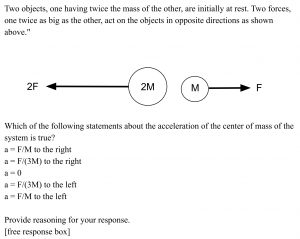System of Two Masses – Case
The students have been discussing a homework problem about a system of two masses. The class is split between thinking the center of mass is not accelerating and that it is accelerating to the left.
“There’s no way…”
Jared shares that he used to think that the acceleration of the CM would be zero but has changed his mind. He checks with others about the first step in his reasoning, that the masses would move the same distance, but with that established he concludes that the CM must be accelerating to the left.
The next minute (not included here in video), consist of Vesal misunderstanding Jared’s argument, and then Jared, Adolfo, and Alejandro rectifying that. Vesal then tacitly endorses that argument as correct.
“I think it would be better if we draw it out.”

Vesal checks in with the class to see whether others have followed Jared’s argument. Adolfo proposes that “we draw it out,” and he sketches the two objects both before (top) and after they have moved (bottom). As he draws, Adolfo explains that the objects will “travel the same distance in the same amount of time because they have the same acceleration,” that first step of Jared’s reasoning.

Mischael interjects that Adolfo’s drawing supports the acceleration being zero.
Adolfo keeps drawing and elaborates, adding an asterisk to each sketch, before and after, marking the original location of the center of mass. , He explains that the CM cannot stay in that spot, “because it has to be closer to 2M.”
Mischael disagrees, “It is closer to the 2M, though,” and in the next segment he explains his reasoning.
“How could the center of mass be in the same place? It would have to move.”

Mischael continues with Jared’s pencil analogy, arguing that if the two sides grow at the same rate, the two sides remain “proportional.” He may be thinking of an equivalence: If the two sides start out equivalent, and they change in the same way, they should remain equivalent.
Kimmee acknowledges and expands on Mischael’s reasoning, in terms of the two sides of the pencil expanding away from the center of mass. But she challenges that reasoning, now using objects on her desk to highlight that in the problem one mass is larger than the other.
Meanwhile, Adolfo changes the diagram to show a new location of the CM after the masses have moved apart.
“I think I know almost exactly what Jared’s saying.”
Joel calls attention to the difference in the distances from M and 2M to the original location of the center of mass: “this distance minus this distance.” He then reasons that if the two objects move farther and farther apart, at the same speeds, that difference would become insignificant. He (correctly) argues that means the center of mass cannot stay in that location, since it has to (significantly) closer to 2M. But several students say they do not follow.
Mischael explains how he sees the distance between the masses and the CM staying proportional even as the masses move.
Joel tries to explain his reasoning with numbers, thinking of the objects moving a million units apart, to show how that initial difference would become negligible. Others object to his using big numbers, and Joel drops that line of argument and loses the floor.
Mischael uses the numbers from Joel’s example to illustrate that proportionality is maintained even when the CM has a zero acceleration, and he heads to the board to explain. Vesal and Joel push against Mischael’s claim that the distances remain proportional. Mischael asks to explain his thinking at the board.
“Even if this [D2] is longer, this [L2] will be even longer.”

Mischael goes to the board to present “one of the orginal arguments” that “is wrong” but, apparently, he wants the class to consider. He begins by adding to the diagram, marking the distance between the CM (asterisk in Figure) and 2M as “D” and the distance between the CM and M as “L.” (So L-D is the difference Joel was considering earlier.)
Mischael argues that because the two masses are accelerating “at the same rate away from one another,” the ratio D/L “will always stay the same.” Other students disagree; Jared argues that for D and L to be proportional, the CM needs to move (i.e. have a non-zero acceleration).
“It seems like they’re disagreeing for a weird reason.”
Vesal interrupts to call on Korri, who has had her hand raised and says she is “combining” Jared and Mischael’s arguments. Korri agrees that the ratio of D/L stays the same as the objects accelerate. She then suggests that “zero acceleration” of the CM was provided as a possible answer on the homework to “kinda trick you into thinking, like, ‘Oh if the proportions stayed the same then there is no acceleration.’” Korri argues that the acceleration has to be non-zero: “ if it was going at constant velocity the proportion would be all messed up…”
“This whole system is wrong!”
Mischael proposes that the two objects are accelerating in the same direction, reasoning that since the masses are a part of the same system, they shouldn’t accelerate in different directions. Throughout Mischael’s explanation, other students—especially Adolfo—protest with apparent lightheartedness.
“Proportionality is multipl[ication].”
Mischael walks away from the board and, with a smile, lets his pencil fall to the ground in a ‘mic drop.’
Alejandro steps up to the board and diagrams the “astronaut problem” (introduced in a prelecture and brought up earlier in the discussion) in which an astronaut throws a wrench in space. In that problem, the force on the astronaut is equal and opposite the force on the wrench. Since the wrench has a smaller mass, it has a proportionally greater acceleration. Alejandro uses numbers to show how the wrench moves farther, keeping the distances to the center of mass proportional. He then uses numbers for the present problem, in contrast: With M and 2M moving the same distances, the proportions change from the initial location of the center of mass.
